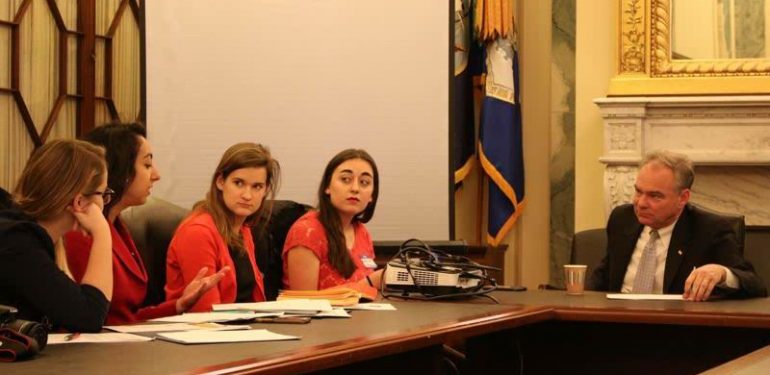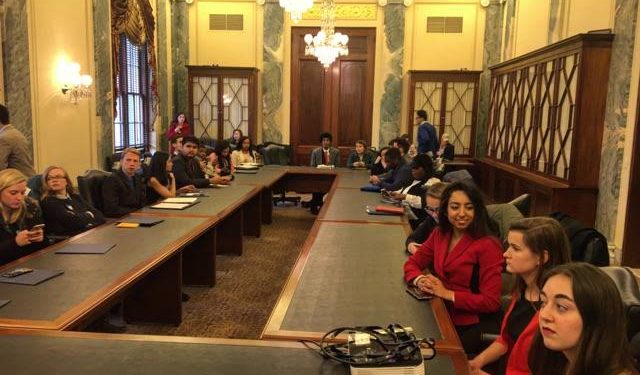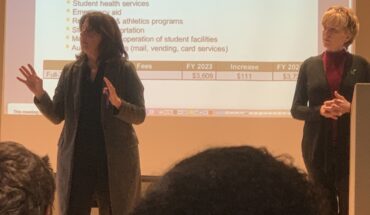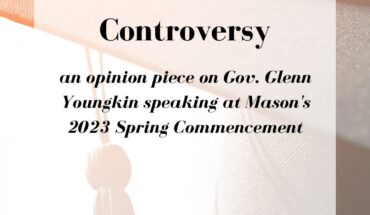Sen. Tim Kaine, journalists discuss higher education financial issues and policy
BY DONNA IMADI
The national organization Young Invincibles sponsored a summit on higher education Feb. 27 that brought together journalists and policymakers to discuss higher education financial issues with Sen. Tim Kaine (D-Va.).
The summit focused on the topic of financial burdens “shadowing the lives of students across the nation who face significantly inflating and skyrocketing college tuition costs,” according to the Young Invincibles leaders at the event.
In addition, the summit connected college students and members of Congress who face the task of combating rising student debt, which broke $1 trillion in 2012 and surpassed credit card debt in 2010, as reported by the Young Invincibles’ loan repayment fact sheet.
Among the participants were 30 student journalists from across the nation, including students from Mason, higher education policy journalists and experts, and legislative officials, including Kaine.
The summit opened with discussion on how “higher education became a hot-button issue in the 2016 election cycle,” as noted by Michael Stratford, an education reporter for Politico.
However, the conversation quickly shifted to address the current concerns of journalists in the room who wanted to “focus on the families and students” who are impacted by the current higher education policies and changes that may occur in the future.
Among these concerns were upcoming policies surrounding higher education issues, such as student loans, Pell grants—subsidies the government provides to students in need of financial assistance—and the reauthorization of the Higher Education Act.
The Higher Education Act is a “sweeping federal law govern[ing] our higher education system, from financial aid programs and student loan systems to quality regulations,” according to a Young Invincibles report. The purpose of the law is to increase opportunities and access to students who “lacked financial means to access higher education.” Yet according to the report, it has not been updated since 2008, and its funding expired in Fiscal Year 2014.
With the resurfacing debate of higher education reform across the nation, student journalists at the event said that updating the Higher Education Act for the 2017–2018 Fiscal Year was vital in light of “debates over what the role of government should be in higher education,” Allie Bidwell, a reporter and editor for the National Association of Student Financial Aid Administration, said.
Bidwell described how deregulating higher education could mean shrinking federal aid programs or streamlining loans to a one grant loan system. This means loan applicants would have to go through one office with just one application rather than sorting through a variety of loans to find the best option, according to a National Association of Student Financial Aid Administration press release.
The results of deregulating and defunding key programs “would be consequential for those who depend on Pell Grants and other forms of federal assistance to help fund their higher education,” Emily Wilkins, an Education and Labor reporter for CQ Roll Call, said.
Any change in federal assistance programs would impact students at Mason as well. In Fiscal Year 2016, nearly 60 percent of Mason students received some form of student aid, and 25 percent received Pell Grants, according to Mason’s 2017 Legislative and Budget Priorities.
Reid Setzer, deputy director of Policy and Legislative Affairs for Young Invincibles, said in a briefing that one of the greater concerns for those in higher education is the impact that the proposed federal budget could have on students who are struggling to fund their college tuition. This is because the proposed budget increases defense spending and decreases education funding.
However, Setzer did outline that there were bipartisan agreements to be optimistic about in 2017, pointing to “simplifying FAFSA, proposing the renewal of a year-round Pell Grant and reforming the student loan repayment system” as issues that both Democrats and Republicans could engage in “constructive dialogue” on.
Kaine welcomed the idea of bipartisan approaches as part of his “philosophy of higher education,” which he then broke down into three main points. He added he hopes to incorporate these points into the reformed Higher Education Act.
Kaine’s first point was redefining what higher education means by expanding the definition to include career, technical education and apprenticeship programs. He said these kinds of programs would ensure that options are available for “students of all ages” to be equipped with “skills needed for the jobs of the 21st century.” He cited a study from Georgetown University that said the U.S. will need millions of workers with postsecondary credentials in the near future to satisfy the labor market’s demand for college-educated workers.
For his second point, Kaine noted the importance of employers having the opportunity to add their input when reauthorizing the Higher Education Act.
“Having vigorous employer representation when writing it will help us incorporate workforce needs,” Kaine said, and added this is “significant in creating educational experiences” that will benefit the labor sector in the long term.
Lastly, Kaine outlined the importance of affordability and supported policies that “better educate families on their options from an early age in middle school to ensure family planning” for higher education.
Kaine was then asked how the federal government plans on addressing the skyrocketing rate at which college tuition is increasing annually. He responded by reemphasizing the importance of giving students “alternative options” to university education, such as career and technical education programs. He also stressed early college planning for students in middle school, placing emphasis on the responsibility of students and parents to plan prior to attending a university.
At the end of the summit, Kaine reminded the group that, throughout the heated debates to come in the next couple of years over education policy, the greatest challenge for government’s role in higher education boils down to ensuring that “[Federal] dollars follow people and students—not institutions.”






